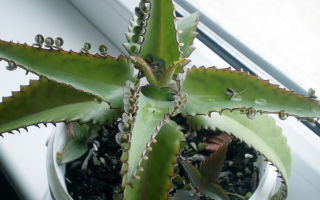Content
- 1 What does Kalanchoe look like
- 2 The benefits of Kalanchoe for the human body
- 3 What heals Kalanchoe
- 4 Kalanchoe during pregnancy
- 5 Kalanchoe for children
- 6 Traditional medicine recipes with Kalanchoe
- 7 Kalanchoe in traditional medicine
- 8 The use of Kalanchoe in home cosmetology
- 9 Harm of Kalanchoe and contraindications for use
- 10 How to store
- 11 Conclusion
- 12 Reviews
The benefits and harms of Kalanchoe are an interesting question for those who plant indoor flowers not only for pleasure, but also for home treatment. It is worth studying the beneficial properties of Kalanchoe and finding out what medicines can be prepared based on it.
What does Kalanchoe look like
Kalanchoe is an evergreen succulent plant from the Tolstyankov family. It is easy to recognize it - the plant has straight, strong stems, on which fleshy and glossy oblong leaves with jagged edges are located opposite each other. The upper leaves are green, the lower ones can have a bluish or light purple tint. The plant does not bloom every year, but it produces unusual and very beautiful flowers with bright red petals.

The plant can become a real gem in the collection of any grower. And yet, the benefits of Kalanchoe for the home are not limited to the external beauty of the plant. The flower is appreciated for the vitamin composition of its leaves, which contain ascorbic acid, polysaccharides, minerals magnesium, iron, aluminum. Kalanchoe juice, when used internally and externally, has health benefits - and is actively used in traditional and home medicine.
The benefits of Kalanchoe for the human body
The beneficial properties of a houseplant are expressed in the fact that Kalanchoe:
- has an antibacterial effect and helps to quickly eliminate inflammation;
- promotes the early healing of wounds, abrasions and burns;
- when used internally, it improves metabolism and helps to normalize bowel movements;
- cleanses the body of toxins and accumulated toxins;
- has a beneficial effect on the gallbladder;
- helps the liver by lowering blood cholesterol levels;
- helps to stop blood from bleeding.
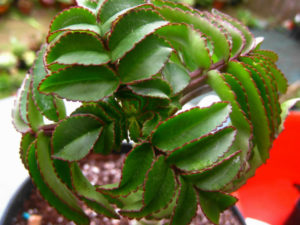
What heals Kalanchoe
The properties of a houseplant are used to treat a wide range of diseases. For example, the beneficial qualities of a flower are in demand when:
- stomatitis and herpes;
- sinusitis and periodontal disease;
- varicose veins and arthrosis;
- ulcer;
- conjunctivitis and otitis media.
With plant juice, ointments and tinctures, they treat skin damage and diseases of internal organs, eliminate infections and strengthen the immune system.
Kalanchoe during pregnancy
The sap of the plant is not included in the list of home remedies that are clearly prohibited while carrying a child. However, doctors recommend treating a home flower with caution and not using it unless absolutely necessary - especially in case of a problem pregnancy.
The fact is that the properties of the plant have not yet been fully studied. All the substances present in the composition, through the woman's body, enter the developing fetus - and theoretically can harm it. In addition, for example, in the treatment of a cold, Kalanchoe causes intense sneezing - while the abdominal muscles contract, which should be avoided by pregnant women.
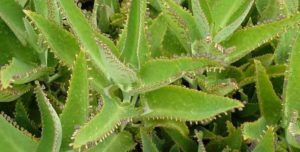
Kalanchoe for children
It is possible to give Kalanchoe to children for a runny nose, cough and sore throat - but only after reaching 3 years. The plant can potentially cause allergies, so babies cannot be treated with it.
When using a home remedy for children, the juice of the plant must be diluted with clean water or milk. The concentrated juice can burn the baby's sensitive mucous membranes.
Traditional medicine recipes with Kalanchoe
In order for the juice of the fleshy leaves to show all its beneficial properties, you need to know exactly how to use the houseplant. There are several of the most popular recipes for the preparation of medicinal products.
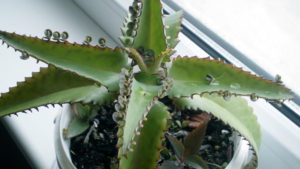
Kalanchoe juice
Most often, juice is used for the treatment of diseases at home - pure or diluted with water or milk. In order to use a healing agent, you do not need to wait, as is the case with decoctions or infusions.
Juicing is very simple - just take the right amount of fresh leaves of the plant and gently squeeze the juice out of them. When applied externally, compresses and lotions for diseased areas are made from the resulting product.
For example, juice compresses are used to treat:
- skin fungus - gauze is dipped in juice, and then applied to a problem area on the skin and fixed with a bandage or plaster, changing the lotion three times a day;
- abscesses and inflamed wounds - a gauze bandage soaked in plant sap is fixed on the affected area and changed once a day; Kalanchoe will also help with burns.
Kalanchoe can be used for oral administration - but for this it must be diluted.
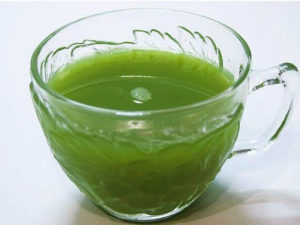
- For the treatment of stomach ulcers or cystitis, 1 teaspoon of fresh juice is diluted in a glass of drinking water and drunk three times a day shortly before meals.
- With a cold, the pomace is diluted with milk in a ratio of 1: 3, and then a couple of drops are instilled into each nostril three times a day.
- Also, for otitis media and colds, you can drip Kalanchoe into your ears - after diluting it with water.
Kalanchoe infusion
For external and internal use, not only fresh juice is used, but also a decoction from the leaves of a houseplant. It is not difficult to make it - you need to pick and grind a sufficient amount of fresh leaves, and then fill them with clean water. In this case, there should be 5 times more water. Then the mixture is heated with steam for 20 minutes, and then cooled and used for medicinal purposes.
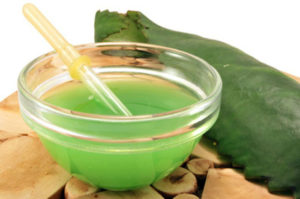
- Helps Kalanchoe from warts, infusion can be used to wipe irritated skin for any dermatological diseases.
- Kalanchoe helps well with purulent wounds, since it disinfects the wound surface and promotes early healing.
- The tool works well for varicose veins, it can also be used to wipe inflamed wounds and healing burns.
- Especially useful is the infusion for rinsing the mouth and throat for angina and periodontal disease - fresh juice is not used for these purposes, since it can leave burns.
- Indoor plant infusion will be beneficial when applied internally for low-acid gastritis or colitis. The tool must be drunk twice a day, shortly before meals, for several sips. The total course of treatment is a month, after which you need to take a break.
For the preparation of the infusion, not only fresh leaves of a houseplant are suitable. Instead, you can buy dry extract at the pharmacy - it has the same beneficial properties.
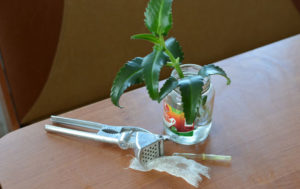
Kalanchoe tincture on vodka
Alcoholic tincture on the leaves of the plant brings great benefits to the body.It is prepared like this - finely chopped leaves are tightly stuffed into a small glass jar, and filled with ordinary vodka on top. The jar is tightly closed and put in a dark place for a week.
- Kalanchoe tincture for joints will be of great benefit - when pain appears, it is recommended to rub the affected areas with this remedy with gentle massage movements. It is best to rub at night in order to cover yourself with a warm blanket immediately after the procedure and give the joints complete rest.
- A tincture of Kalanchoe juice will be useful for colds - a vodka-based remedy can rub the chest and throat to properly warm up the deep layers of the skin. Also, the agent is taken orally - twice a day until the symptoms disappear. However, the liquid is not consumed in its pure form - 1 teaspoon must be diluted in a glass of drinking water and only then drink in small sips.
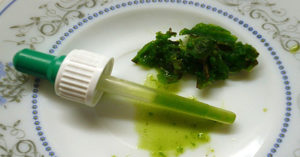
Kalanchoe tincture on alcohol
An alcoholic tincture on the leaves of the plant is prepared as follows - 2 large tablespoons of chopped fresh leaves are poured with a glass of alcohol in a small glass container, corked and removed in a dark place for 12 days.
After the due date has passed, the finished product can be filtered and used for home therapy. If the drink is to be consumed inside, the medicine must first be diluted with water - in a ratio of 1 glass to 1 teaspoon, so as not to harm the body.
- A tincture of Kalanchoe for prostatitis will be very useful - a medicine diluted in water, used in the morning before breakfast and in the evening shortly before dinner. In total, you need to take the drug for 40 days, and with the onset of relief, the dosage is reduced by 2 times.
- The remedy is used to treat colds - however, in this case, the healing properties of Kalanchoe will be good only for adults, children will be harmed by them. Half a teaspoon is diluted in a glass of warm water and gargled 4 times a day.
- The benefits of alcoholic tincture on Kalanchoe will manifest itself with varicose veins. Such therapy should be carried out no longer than 2 weeks in a row - then they take a break for another 10 days.

Kalanchoe ointment at home
For the treatment of fungus, skin ailments and injuries, not only rubbing with juice and alcoholic tinctures is used. You can prepare a useful ointment - for this, 45 ml of fresh Kalanchoe juice is mixed with 90 g of lanolin, and then literally 1/4 g of furazolidone and novocaine are added. Homemade ointment is thoroughly mixed until smooth.
Kalanchoe ointment is very useful for varicose veins, for dermatitis and fistulas, for abscesses and frostbite. The composition treats burns and even bedsores at the healing stage, a remedy for plentiful acne helps. You can lubricate the skin with the product no longer than 15 days in a row, so as not to cause harm.
Kalanchoe from a cold
Homemade drops from plant sap are the most popular - they are excellent help with severe nasal congestion. Before use, the product is diluted with milk or water to avoid harm from a burn of the mucous membrane, no more than a couple of drops are dripped into each nostril.
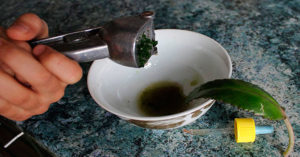
Kalanchoe in traditional medicine
The mainstream medical science took notice of the Kalanchoe in the early 1960s. Studies and clinical trials were carried out, during which the beneficial properties of the plant were confirmed and it was found that Kalanchoe, when consumed, will not harm. And in 1966 the juice of the plant and ointment based on it entered the State Register of Medicines. True, for a long time, drugs were used only externally - to treat burns, wounds and ulcers.
At the moment, there are preparations based on Kalanchoe for both external and internal use.They have antiseptic and immunomodulatory properties, therefore they are used for a variety of ailments.
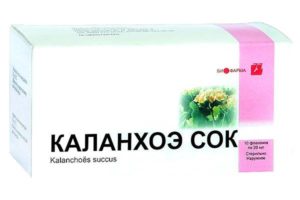
The use of Kalanchoe in home cosmetology
The beneficial properties of the plant are used not only for treatment, but also for taking care of external beauty. Masks and lotions are applied in a complex for the body, face and hair - and bring a good effect.
For facial skin
The benefits for the face are that the properties of the plant normalize the oily skin, can eliminate rashes and age spots, cleanse pores and relieve irritation.
- In order to cleanse the skin and even out its color, the skin is removed from the leaf of a home flower, exposing the pulp, and the face is rubbed. After that, you need to massage the skin with light movements and leave the product to be absorbed, and then apply a moisturizer.
- To slightly dry oily skin, mix the dried leaves of chamomile, linden and mint, pour boiling water and leave for half an hour. After the product has cooled, the water is drained, and the herbs are mixed with Kalanchoe juice and applied to the face for 20 minutes.

Kalanchoe for hair beauty
Useful masks and decoctions based on Kalanchoe strengthen hair, make it thicker and softer, and give it a pleasant natural shine. The following tool is popular:
- in small volumes of 5 ml, Kalanchoe juice, garlic and birch sap are mixed;
- add a small spoonful of honey and egg yolk;
- mixed and applied to hair for 2 hours.
The head must be wrapped with cling film and a warm towel so that the product is properly absorbed. Then the mask is washed off using shampoo.
For hands and nails
Kalanchoe is an excellent remedy for softening the skin of the hands. In addition, the Kalanchoe nail fungus is being treated - the antiseptic properties of the plant quickly heal the nail plate and cuticle.
- To take care of your hands, you can simply add a few drops of fresh plant juice to a regular cream. It is better to smear your hands at night, and it is recommended to wear cotton gloves on top.
- If you need to cope with nail fungus, it is recommended to wrap each of the nail plates with gauze soaked in healing juice - and also put on gloves on top. The procedure is carried out daily or every other day until the disappearance of the fungus.
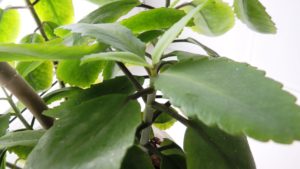
Harm of Kalanchoe and contraindications for use
The harm and health benefits of Kalanchoe balance each other - despite the valuable properties of the plant, sometimes it is forbidden to use it. Namely, Kalanchoe cannot be used:
- with chronic low blood pressure;
- with oncological tumors;
- with hepatitis and other liver ailments;
- with serious joint problems;
- if you are allergic to a natural remedy.
The use of Kalanchoe tincture and other home preparations requires careful adherence to the dosage. If you exceed the recommended amounts, the product will cause heartburn, diarrhea, and when applied externally, it will harm mucous membranes and skin.
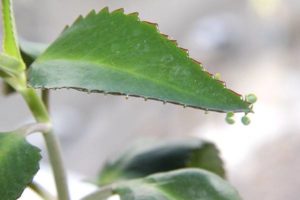
How to store
So that the leaves from a home flower do not have to be cut off too often, it is better not to pour out the surplus of prepared medicinal products, but to store them.
- The healthy juice of a home plant retains its medicinal value for a week, and it must be kept in a glass container.
- Kalanchoe ointment can be stored for a month - even outside the refrigerator.
- The beneficial properties of tinctures on alcohol and vodka preserve the longest - they will calmly stand in the refrigerator for 3 months.
But a solution with the addition of milk for instillation into the nose or ears cannot be stored at all - a fresh product is prepared before each use.
Conclusion
The benefits and harms of Kalanchoe depend on how carefully the rules for use are followed. If you take the product a little and in low concentration, it will not cause harm.

